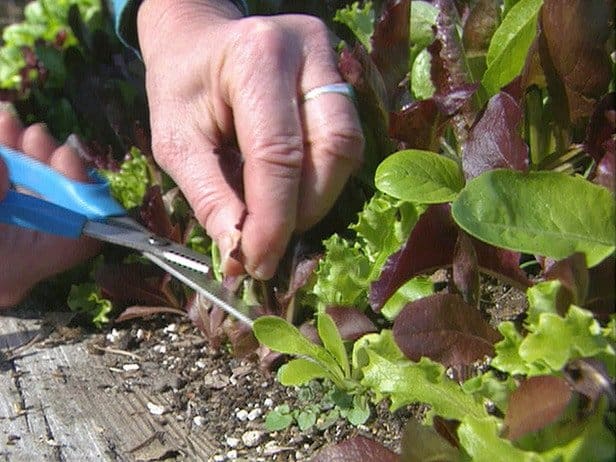
If you have lettuce seed packets hanging around from spring, now would be a good time to plant lettuces to be harvested this fall.
Using a readymade mesclun mix is a quick way to get something good in your salad bowl. The seed is scattered, and individual baby leaves are cut (using scissors, never ripped by hand) from small plants, allowing the developing central crowns to remain and make more leaves. Mesclun mixes are often formulated to include interesting salad greens with particular flavours (mild or spicy), or you can make your own by combining lettuce varieties you already have on hand. If you want to grow full heads of lettuce, start seed indoors and then transplant into the ground or containers.
My plan usually involves removing the summer annuals in the big concrete container by my front door and setting it up for lettuce production. I remove the annuals’ roots from the soil and check that the drainage is adequate. The growing medium already in the container is a soilless mix that can be used again. But if there were plant disease or insect problems, I start with a fresh bag of soilless mix, to which I add gradual-release fertilizer pellets formulated for container growing.
Most lettuce requires light to germinate and a consistently moist environment. After readying the soil, add sufficient water to ensure there are no dry pockets and use a hand rake to smooth the surface. Scatter lettuce seeds fairly thickly (you can harvest from areas that may become too crowded) and cover with a thin layer of grass clippings or barely a half inch (1 cm) of peat moss. Sprinkle or spray a fine mist of water over the seedbed every day, and check that wind doesn’t dry it out too quickly.
Watch for germination in about 10 to 14 days and begin to harvest when each little plant has four to six small leaves. Use scissors to remove half of the leaves from each plant. Plants will begin to regenerate leaves quickly, and soon you’ll be harvesting whole bowls of sweet greens for your early autumn table. If early frost threatens at night, cover the plants with newspapers (held down with rocks), a lightweight tarp or sheer window curtains. Lettuce doesn’t mind cool temperatures and should keep producing well into October.

Leave a Reply